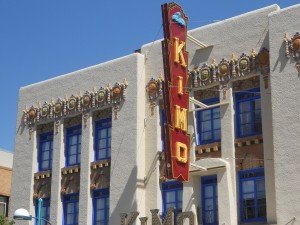If your western travels take you to Albuquerque New Mexico, a stop by one of the city’s most well known landmarks makes for a great side trip. The Kimo Theater located in the heart of the city at 423 Central Avenue NW is a historic site indeed. The first thing you’ll notice is the theaters very colorful art deco motif.
Thank you for reading this post, don't forget to subscribe!
The Kimo Theater was constructed in 1927 in what is referred to as an Art Deco-Pueblo Revival Style of architecture. The art deco look at the Kimo blends the Native culture of the southwest in it’s natural colorful spirit. The years of the 1920’s saw construction of movie theaters explode around the country with all types of architectural designs but the motif used with the Kimo was much more rare. The Pueblo Deco style had a relatively short life span during the 1920’s and the Kimo stands as rare and excellent example of that era.
The theater was originally built to show both motion picture and stage productions. It’s site had many passers by in as much as it sits directly on the old Route 66 through Albuquerque. The Kimo was built for Italian immigrant Oreste Bachechi at a cost of $150,000. The idea was to create a theater that stood out and it did. Bachechi, who arrived in Albuquerque in 1884, had been an operator of a general store near the railroad tracks and eventually found himself in the entertainment business.

Bachechi’s Albuquerque arrival was at a fortunate time for the city and his personal properity. The Atchison Topeka and Santa Fe Railroad had recently laid track to the city with Albuquerque being made a division point. This meant more people and more jobs. In 1919 he began the Bachechi Amusement Association. Along with a partner he ran the Past Time Theater. As far as the Kimo’s name, Bachechi had a contest to name his new theater. The winning entry was Kimo and the author of the name, the then Governor of Isleta Pueblo, received a $50 prize. As for what the name Kimo means, it’s a combination of two Indian terms which translate to “mountain lion” or sometimes “king of it’s kind“.

As for the buildings appearance, the exterior of the brick three story building is made of textured light brown stucco decorated with ornamental details of glazed terra cotta tile. When you visit the Kimo Theater you’ll see just how uniquely designed it is. The interior for example includes air vents that look like Navajo rugs and chandeliers the shape of Indian war drums. There are also seven murals that show Seven Cities of Cibola or sometimnes referred to as the Seven Cities of Gold. This was the original goal of the 1540 Coronado Expedition through the southwest. The history of the Kimo Theater includes appearances by such big entertainment names as western star Tom Mix and famous actress Gloria Swanson.
Unfortunately Oreste Bachechi died just one year after the new theater opened. Management was then taken over by his sons who decided to showcase a combination of motion pictures and vaudeville acts.

At one time the Kimo Theater faced the wrecking ball but fortunately it was saved when the city of Albuquerque stepped forward and bought the historic building. When the city bought the theater it had deteriorated significantly and several restoration projects were scheduled. The Kimo was completely restored to the shape it was in during it’s heyday and now is a much visited venue.
Today the Kimo Theater entertains with stage plays, movies and concerts, guest speakers as well as civic movies and events. The theater has also been used for school graduations. The auditorium seats 650 people and although there is a balcony section, the building was constructed without an elevator. Because of the works of art inside the Kimo, it also serves as a southwestern art gallery.
The Kimo is also one of those old historic buildings with rumors of a haunting. This particular haunting pertains to a boiler explosion that occurred in 1951 an killed a six year old boy. Some have reported actually seeing the ghost of the boy although an investigation made by an editor from the Skeptical Inquirer disputed the origins of the alleged haunting.
Two articles we’ve published on our Western Trips Site regarding historic stops near the Kimo Theater are Old Town Albuquerque and the Old Alvarado Harvey House.
Being located on Central Avenue in the heart of Albuquerque, there are plenty of historic stops very nearby. These include Old Town Albuquerque which is only about 2 miles to the west. Another is the site of the old Alvarado Harvey House which is now the Alvarado Transportation Center for city buses and the New Mexico Rail Runner train. This site is about one-half mile east of the Kimo on Central Avenue.
